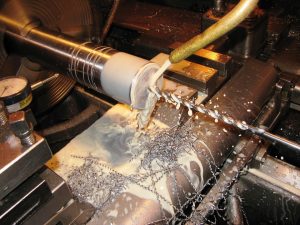
A lathe is an essential machine used in the manufacturing industry. Among other things, it can be used to cut, sand and turn workpieces. Not to be confused with milling machines, lathes are designed to rotate a workpiece against a tool bit. The workpiece rotates against a stationary tool bit, such as a blade or drill bit. While there are different types of lathes, most feature a few basic parts to facilitate their operations.
Bed
The bed is a large horizontal structure or beam that’s used to support other parts of a lathe like the headstock and tailstock. With the exception of woodworking lathes, nearly all lathes have a bed. It’s the long platform on which these parts are mounted.
Headstock
Found on the end of the bed is the headstock. Once clamped to the end, the headstock provides the rotational power for the lathe’s operations. It contains the bearings used by the lathe to rotate the workpiece against the tool bit.
Tailstock
As you may have guessed, the tailstock is found on the end of the lathe opposite to the headstock. Also known as a “loose head,” the tailstock features a non-rotating barrel that can be used for a variety of purposes, such as holding tool bits or supporting workpieces while they turn.
Carriage
Lathes also have a carriage, which is found nestled between the headstock and tailstock. The carriage is responsible for guiding the tool bit as it cuts or otherwise manipulates the workpiece.
Legs
Of course, legs are the vertical structures on a lathe that provide an elevated working surface. Lathes don’t use just any type of legs, however. Because of their heavy weight, commercial-grade lathes usually feature legs that bolt onto the floor on which it’s placed. By bolting the legs down, the lathe will remain stable even under heavy load.
Cross Slide
The cross slide is a component found on the top of a lathe that allows the tool bit to slide back and forth.
Saddle
Found on the top of a lathe is the saddle. Technically, the saddle is part of the carriage. Featuring a H shape, it’s responsible for supporting cross slide movements.
Apron
The apron is a part of a lathe that’s clamped to the saddle. It’s designed to hold the gears, levers and other components that push the cross slide. Along with the saddle, the apron is a key component of the carriage, which as mentioned above, is used to guide the lathe’s tool bit.
No tags for this post.